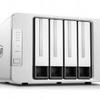Introduction
TerraMaster F4-423 4-bay NAS
Today, we will study the Terra MasterF4-423 four-bay NAS. TerraMaster is a supplier of network storage solutions. At the heart of this NAS, you will find an Intel Jasper Lake Intel Celeron N5105/5095 processor, 4GB RAM, and two 2.5 Gigabit Ethernet connections. The list price of the item being evaluated is $499. The TerraMaster F4-423, with its four 2.5"/3.5" HDD/SSD trays, it also has two M.2. slots (PCIe Gen 3.0). It is fitted and equipped with an Intel 10 nm Celeron N5105 CPU, a quad-core with 2 GHz base speeds, and a maximum turbo of 2.9 GHz. This new model is designed with a professional consumer in mind. However, we believe that every family should have a NAS device. The F4-423 comes into play if you demand rapid and huge capacity storage for movies transmitted to several devices. In addition to its four 3.5" and compatible 2.5" slots (which thus can accommodate SATA3 HDDs and SSDs). If you have a Multi-GigE Ethernet infrastructure, you can achieve 300 MB/sec across a single Ethernet connection, and the CPU is more than quick enough to keep that file stream locked and loaded. These essential qualities alone make this a very effective NAS, period. It contains all the features of Asustor, plus more.
- Two 2.5 GbE ports with up to 5 Gbps under Link Aggregation
- 4K HDMI output / transcode H.265 (HEVC), MPEG-4 Part 2, MPEG-2, VC-1
- Quad-Core Intel Celeron N5105 2.0 Ghz - 2.9 Ghz turbo
- 4GB DDR4-2933/3200
- Supports Wake on LAN and Wake on WAN
TerraMaster gave this NAS series a suitable processor; it is a 10W TDP Intel Celeron N5105 (Jasper Lake; 10nm). The four CPU cores of the Tremont-based processor architecture operate between 2 and 2.9 GHz (single-core Burst) but lack HyperThreading (SMT). The N5105 has 1.5 MB of L2 cache and 4 MB of L3 cache. Intel manufactures the chip at 10nm. Tremont is a redesigned CPU architecture compared to the Golmont Plus cores of its predecessor. It has a 4K enabled iGPU with embedded graphics support (mostly used as a transcoding engine for NAS). That means that both the native media applications from Asustor and Plex Media Server will support transcoding (Plex does require a premium subscription to activate that, though). So that offers plenty of performance while remaining energy efficient as well. A NAS is, in fact, a server, so it'll need some system memory as well. Included is 4GB of DDR4 (SO-DIMM) memory; however, you can drop in another 4GB through the extension port to reach a total of 8GB. But up to 32 GB in total is supported over two DIMMs.
You will also note that thanks to hardware transcoding engine codecs like H.265 (HEVC), MPEG-4 Part 2, MPEG-2, VC-1; maximum resolution: 4K (4096 x 2160); maximum frame rate per second (FPS): 60. So you may view high-quality videos from YouTube and Twitch as soon as the NAS device's HDMI 2.0a output is activated. The software included with your purchase of a NAS includes largely first-party media management, file management, backup, and system utilities. There is also support for the more recent docker/container program for operating smaller virtual environments; VirtualBox is supported for larger VMs and features ClamAV Protection for protection against intrusion, malware, viruses, and more. We evaluate the 4-bay model, which is packed with capabilities and a wealth of software that enables anything from a basic FTP server to VM-aware solutions and an abundance of media functions. MySQL (MariaDB) support is featured on the F4-423, which can perform various jobs. Desktop software (PC/MAC) with a Linux-based graphical user interface may operate the NAS (GUI). Additionally, Android and iOS apps may be used to monitor the NAS. I will put this device to the test using a pair of SSD disks I have lying around.
|
Terra Master F4-423 |
|
| Connections | 2 × RJ45, 2.5 Gbps 2 × USB 3.0, HDMI 2.0 |
| CPU / RAM | Celeron N5105 / 4 GB DDR4L (max. 32 GB) |
| Price | 499 USD |
If you decide to add HDD, power consumption can rise towards 40-50 Watts, however, can drop below 15 watts because of the device's 10-minute 'duty cycle' capability if the disks inside the NAS are idle for more than 10 minutes, they will go to sleep. This should help minimize power usage and noise while extending the drive's life. Let's put it all into practice and see how it goes.


